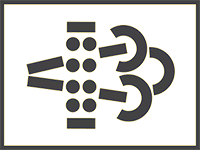
A diesel particulate filter (or DPF) is a device designed to remove diesel particulate matter or soot from the exhaust gas of a diesel engine.
Starting with 2007 model years, diesel trucks or diesel engine equipment are equiped with a diesel particulate filter (DPF). DPFs grab soot from your exhaust before it blows out into the environment. It’s a wall-flow filter usually made of cordierite, silicon carbide, or a ceramic monolith.
As the exhaust gases pass through the filter, it captures somewhere between 85%-100% of diesel particulate matter (DPM). So much of the DPM is removed that you could place a white handkerchief over the exhaust pipe and it would stay white.
DPF maintenance is relatively straightforward. Over time, soot builds up in the filter walls and must be cleared out. A warning light usually shows up indicating it is time to literally burn out the accumulated soot. This process of burning is called regeneration. In addition to regeneration, periodic DPF cleaning is required too.
DPF filters go through a regeneration process which removes this soot and lowers the filter pressure. There are three types of regeneration: active, passive, and forced. Active regeneration happens while the vehicle is not in use and takes 10 minutes on average to complete. Passive regeneration takes place while driving using the heat of the exhaust. This works well for vehicles that drive longer distances with few stops compared to those that perform short trips with many starts and stops. If the filter develops too much pressure then the last type of regeneration must be used - a forced regeneration. This involves a garage using a computer program or truck scanner like FCAR Truck Scanner to run the car, initiating a regeneration of the DPF manually, called Forced Regen.
When active regen requirements aren’t met, or when soot levels rise to a certain point, a forced regeneration may be required. A diagnostic tool is required to force regeneration. Continuing to operate the vehicle at this stage can ruin the DPF and cause other damage.
But even a forced regen will not work if soot levels have grown so high they have overwhelmed the DPF. At about 85% soot capacity and above, the DPF will need to be either removed and cleaned, or replaced.
The DPF must be cleaned every 150,000 to 300,000 miles to remove accumulated ash. This ash buildup is not necessarily related to regens, but is most often due to sulfated ash in the engine oil. The filter must also be cleaned if a fuel injector or turbo problem causes contamination with engine oil or non-combusted diesel. This contamination causes unacceptable back pressure.
Timewise, cleaning a DPF or forced regen should be quick enough to be accommodated during an oil change.
Belows are instruction or path how to make forced regen from difference diesel engines by using FCAR Truck Scanner. The forced regen might fail if the conditions doesn't meet (ie, temperature is lower than 122F, existing DPF codes or soot level too high). Check all the conditions carefully.
